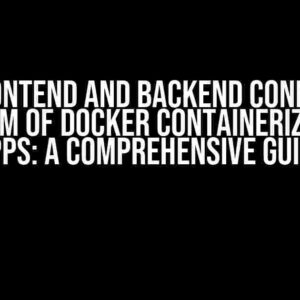Are you tired of those generic error messages that leave your users feeling frustrated and confused? Do you want to take control of your error handling and provide a better user experience? Look no further! In this article, we’ll show you how to make custom error messages on Laravel Precognition, the popular PHP framework.
Why Custom Error Messages Matter
Custom error messages are essential for any web application. They help you:
- Provide a better user experience by giving users clear and concise error messages
- Enhance your application’s security by hiding internal server errors
- Improve your debugging process by providing more informative error messages
- Stand out from the competition by offering a more personalized experience
Understanding Laravel’s Error Handling
Laravel provides a robust error handling system that allows you to catch and handle errors in a centralized way. By default, Laravel uses the `ExceptionHandler` class to handle errors. This class is located in the `app/Exceptions` directory.
// app/Exceptions/Handler.php
namespace App\Exceptions;
use Exception;
use Illuminate\Foundation\Exceptions\Handler as ExceptionHandler;
class Handler extends ExceptionHandler
{
public function report(Exception $exception)
{
parent::report($exception);
}
public function render($request, Exception $exception)
{
return parent::render($request, $exception);
}
}
Creating Custom Error Messages
To create custom error messages, you need to override the `render` method in the `ExceptionHandler` class. This method is responsible for rendering the error page.
Step 1: Define Your Error Codes
Create a new file called `ErrorCodes.php` in the `app/Exceptions` directory. In this file, define your error codes as constants.
// app/Exceptions/ErrorCodes.php
namespace App\Exceptions;
abstract class ErrorCodes
{
const INVALID_REQUEST = 400;
const UNAUTHORIZED_ACCESS = 401;
const RESOURCE_NOT_FOUND = 404;
const INTERNAL_SERVER_ERROR = 500;
}
Step 2: Override the `render` Method
In the `ExceptionHandler` class, override the `render` method to handle errors based on their error codes.
// app/Exceptions/Handler.php
namespace App\Exceptions;
use App\Exceptions/ErrorCodes;
use Exception;
use Illuminate\Foundation\Exceptions\Handler as ExceptionHandler;
class Handler extends ExceptionHandler
{
public function render($request, Exception $exception)
{
switch ($exception->getCode()) {
case ErrorCodes::INVALID_REQUEST:
return response()->view('errors.invalid-request', [], 400);
case ErrorCodes::UNAUTHORIZED_ACCESS:
return response()->view('errors.unauthorized-access', [], 401);
case ErrorCodes::RESOURCE_NOT_FOUND:
return response()->view('errors.resource-not-found', [], 404);
case ErrorCodes::INTERNAL_SERVER_ERROR:
return response()->view('errors.internal-server-error', [], 500);
default:
return parent::render($request, $exception);
}
}
}
Step 3: Create Error Views
| Error Code | |
|---|---|
| 400 | invalid-request.blade.php |
| 401 | unauthorized-access.blade.php |
| 404 | resource-not-found.blade.php |
| 500 | internal-server-error.blade.php |
For example, the `invalid-request.blade.php` view might look like this:
@extends('layouts.master')
@section('content')
Sorry, it looks like you made an invalid request.
@endsection
Best Practices for Custom Error Messages
When creating custom error messages, keep the following best practices in mind:
- Be clear and concise: Error messages should be easy to understand and concise.
- Be friendly and approachable: Use a friendly tone to make your users feel more at ease.
- Provide solutions: Offer solutions or next steps to help users resolve the issue.
- Test thoroughly: Test your error messages to ensure they’re displayed correctly.
- Keep it consistent: Use a consistent tone and style throughout your error messages.
Conclusion
Custom error messages are an essential part of any web application. By following the steps outlined in this article, you can create informative and user-friendly error messages that enhance your application’s overall user experience. Remember to keep your error messages clear, concise, and friendly, and don’t forget to test them thoroughly.
With Laravel Precognition, creating custom error messages is a breeze. By overriding the `render` method in the `ExceptionHandler` class, you can handle errors in a centralized way and provide a better user experience. So, what are you waiting for? Start creating your custom error messages today!
Frequently Asked Question
Get the inside scoop on creating custom error messages on Laravel Precognition, the easiest way to boost your app’s user experience!
Q: How do I create a custom error message in Laravel?
To create a custom error message in Laravel, you can override the default error messages in the `resources/lang/en/validation.php` file. Simply add your custom error messages to this file, and Laravel will automatically use them when validation fails. You can also create a custom error message for a specific field by adding a `messages` array to your validation rule.
Q: Can I use a custom error message for a specific validation rule?
Yes, you can! To use a custom error message for a specific validation rule, you can add a `messages` array to your validation rule. For example, if you want to create a custom error message for the `email` field, you can add the following code to your validation rule: `[’email’ => ‘required|email’, ‘messages’ => [’email.required’ => ‘Please enter a valid email address’]].`
Q: How do I display custom error messages in my Laravel view?
To display custom error messages in your Laravel view, you can use the `$errors` variable provided by Laravel. This variable contains all the error messages for the current request. You can loop through the `$errors` variable and display each error message using a `@foreach` loop. For example: `@foreach ($errors->all() as $error) {{ $error }} @endforeach`.
Q: Can I use custom error messages for different languages?
Yes, you can! Laravel supports multiple languages, and you can create custom error messages for each language. To do this, create a separate `validation.php` file for each language in the `resources/lang` directory. For example, if you want to create custom error messages for French, create a `resources/lang/fr/validation.php` file and add your custom error messages to this file.
Q: How do I test my custom error messages in Laravel?
To test your custom error messages in Laravel, you can use the ` Tests\Unit` directory to write unit tests for your validation rules. You can use the `assertSessionHasErrors` method to test if the correct error messages are being displayed. For example: `$this->post(‘/register’, [‘name’ => ”, ’email’ => ‘invalid’])->assertSessionHasErrors(’email’);`.





